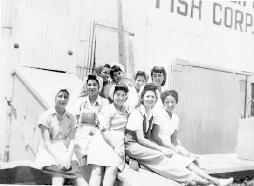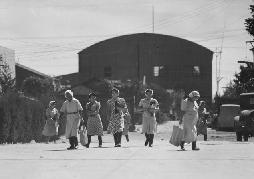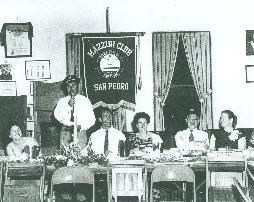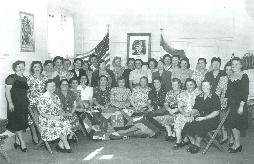SPANISH & MEXICAN CULTURE
San Pedro was part of the first Spanish land grant in California. In 1784, King Carlos III granted 75,000-acres to Juan Jose Dominguez, a retired Spanish soldier and early California explorer. The Mexican influence has remained present in San Pedro and neighboring communities. Twentieth-century Mexican and Mexican-American women and men were a strong part of cannery production.
Mexican Hollywood
In the 1940s an area on the north end of the waterfront, between First Street and where the Vincent Thomas Bridge now stands was informally known as "Mexican Hollywood." Once a small community of Mexican immigrants it is now Berth 93 and a vast Port parking lot.
HEAR Tina Ursich remember Mexican Hollywood.
|
 |
| Mexican-American cannery workers break for lunch outside the Southern California Fish Corp., 1947. ~ Los Angeles Public Library/Shades of L.A. |
|
|
 |
| Japanese Cannery Workers, Terminal Island, 1940. ~ Daily News (Los Angeles, CA)/ Dept of Special Collections/UCLA Library (pending permission) |
|
| JAPANESE NEWCOMERS
In the 1910s Japanese immigrants had already began to fish and settle in the harbor area. By the mid-1930s, Fish Harbor, at the southwestern end of the island, was home to close to 3,000 Japanese fishing families. Japanese and Japanese-American Terminal Islanders spoke a patois of Japanese and English and children participated in Japanese and American activities. As a whole, Terminal Island was well known for its Japanese fishing fleet and waterfront row of grocers and dry goods shops.
CONNECT to the
Virtual Oral/Aural History Archive at CSU Long Beach to HEAR memories about fishing and canning from former Japanese, Japanese-American, and others who lived on Terminal Island before World War II.
|
SOUTHERN-EUROPEAN NEWCOMERS
Particularly from the island of Ischia off the coast
Naples, Italians were making their way, during the pre-WWI years, from
southern Italian fishing villages to American fishing communities.
HEAR Margie Falcone remember the cultural diversity in San Pedro when she was a child.
|
 |
| Founded in 1926 and named after 19th century Italian Patriot Giuseppe Mazzini, the San Pedro club was primarily a social and fund raising groups. (click on image for more), nd. ~ San Pedro Bay Historical Society |
|
|
 |
| During World War II, club members identified as American. Here, women of the club of pose beneath a portrait of Tito, more as a symbol of homeland than out of support for a political regime. (click image for more) nd, c. 1944. ~ San Pedro Bay Historical Society. |
|
| CROATIAN NEWCOMERS
From island fishing villages off the Dalmatian coast of Croatia,
on the Adriatic Sea, Croatians immigrated to the American west coast.
At the time known as Austrian, Slovenian, Jugo-Slav, Yugoslav, or
Slav, Croatian San Pedrans emigrated primarily from the city of Split or the islands of Vis, Brac, and
Korkula.
|
|
|